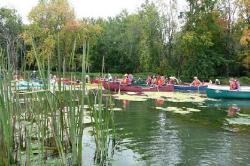Conservation authorities make Ontario livable. We need to defend them

Nottawasaga River
By Shawn Micallef Toronto Star
Threats come in various forms. Some are natural.
There’s a plaque in the Humber River floodplain, just below the Old Mill subway station, that tells the tale of how Hurricane Hazel killed 81 people across various GTA watersheds in 1954. Another plaque further up river near Lawrence Ave. memorializes the Raymore Dr. subdivision, where 14 homes were swept away by Hazel and 32 of the 81 people were killed.
Preserved as parkland now, the event has become part of the founding story of modern Toronto, yet it was also a moment when the importance of conservation authorities became starkly clear. In 1946, the result of pressure from citizen groups who were concerned about decades of poor land use, water and forestry practices, the Conservation Authorities Act was legislated by the Ontario government. It allowed the province and municipalities to create conservation authorities together.
Hazel triggered an expansion of that legislation. After the storm, smaller conservation authorities in Toronto were merged to form what today is the Toronto and Region Conservation Authority (TRCA) and authorities were given the power to acquire and regulate land for community safety, recreation and conservation purposes. Since 1946 other conservation authorities formed and expanded around the GTA and across Ontario.
Further up the Humber, just south of where the river passes under Steeles Ave. is yet another plaque, this one marking what was once Tarmola, an athletic and cultural retreat established by the Finnish Society of Toronto in 1927. Cottages near here were also swept away during Hazel, and in 1968 Tarmola and the area around it was purchased by the TRCA.
Conservation authorities make Toronto and the rest of Ontario livable. Literally. They do important flood mitigation and conserve landscapes that will increase our resilience to the effects of climate change.
The journey up the Humber is a tour of how modern conservation authorities evolved, and they have continued to expand their local programming and practices, making it not just a livable place, but also a very good place to live.
So many of the places I and perhaps you love around here, places that give us a bit of an escape from the intensity of the city, fall under the full or partial jurisdiction of various conservation authorities, such as the Glen Major Forest, a former aggregate quarry that has been wonderfully renaturalized with trails north of Ajax.
Within Toronto, there’s the ongoing Meadoway project converting 16 kilometres of hydro corridor in Scarborough into a linear park. Near Milton, there’s the fantastic view of the entire GTA from Rattlesnake Point. Limehouse Area has similar views further north on the Niagara Escarpment, where limestone kiln ruins are also part of the experience. All preserved and maintained by conservation authorities.
This smashed house was one of the few that was left when after floods from Hurricane Hazel washed away roughly a dozen houses on Raymore Dr. in 1954.
On top of these and many other locations are hiking and education programs, historic interpretive centres such as Black Creek Village and kayak and canoe excursions. The fees for these and other programs help pay for the conservation efforts, and why the Aug. 16 letter from Jeff Yurek, Minster of the Environment, Conservation and Parks, was deeply concerning to conservation authorities.
The threat this time is political.
“Blindsided,” said the head of Conservation Halton of Yurek’s intention to have authorities “refocus” their efforts on their “core mandate” and away from “activities such as ziplining, maple syrup festivals and photography and wedding permits.” In his letter, Yurek drew a connection to Bill 108, his government’s “More Homes, More Choice Act” that makes it easier to develop land and weakens environmental protections.
Mentioning wedding permits is curious. This is the kind of thing that was started not to create something but respond to it: imagine the chaos of bride- and groom-zillas fighting over photo locations on Saturday afternoons. It’s simple regulation and fee collection, and makes enjoying something Ontarians love more pleasant and possible.
What’s even more concerning is how this will undermine these authorities not just financially, but in their conservation efforts as well. What all those programs do is get people out and into the Ontario landscape. We get to know the land and, if you’re like me, grow to love it. It builds a constituency for conservation lands: people who will stand up for it when it’s threatened.
In January, the Ford government backed away from parts of their Bill 66 legislation that would have opened the Greenbelt to development, saying they heard “loud and clear” from Ontario municipalities who did not want it touched. The Greenbelt has a mighty constituency.
Conservation authorities play the same role but are much more decentralized than the giant, consolidated Greenbelt, making them easier to overlook. Many people may not even realize how a conservation authority touches their lives. By undermining their constituency, it will further disconnect people from their critical work.
Look around and see if a conservation authority affects your life in some way. If it does, and you like it, you’re going to have to start defending it.









Leave a Reply